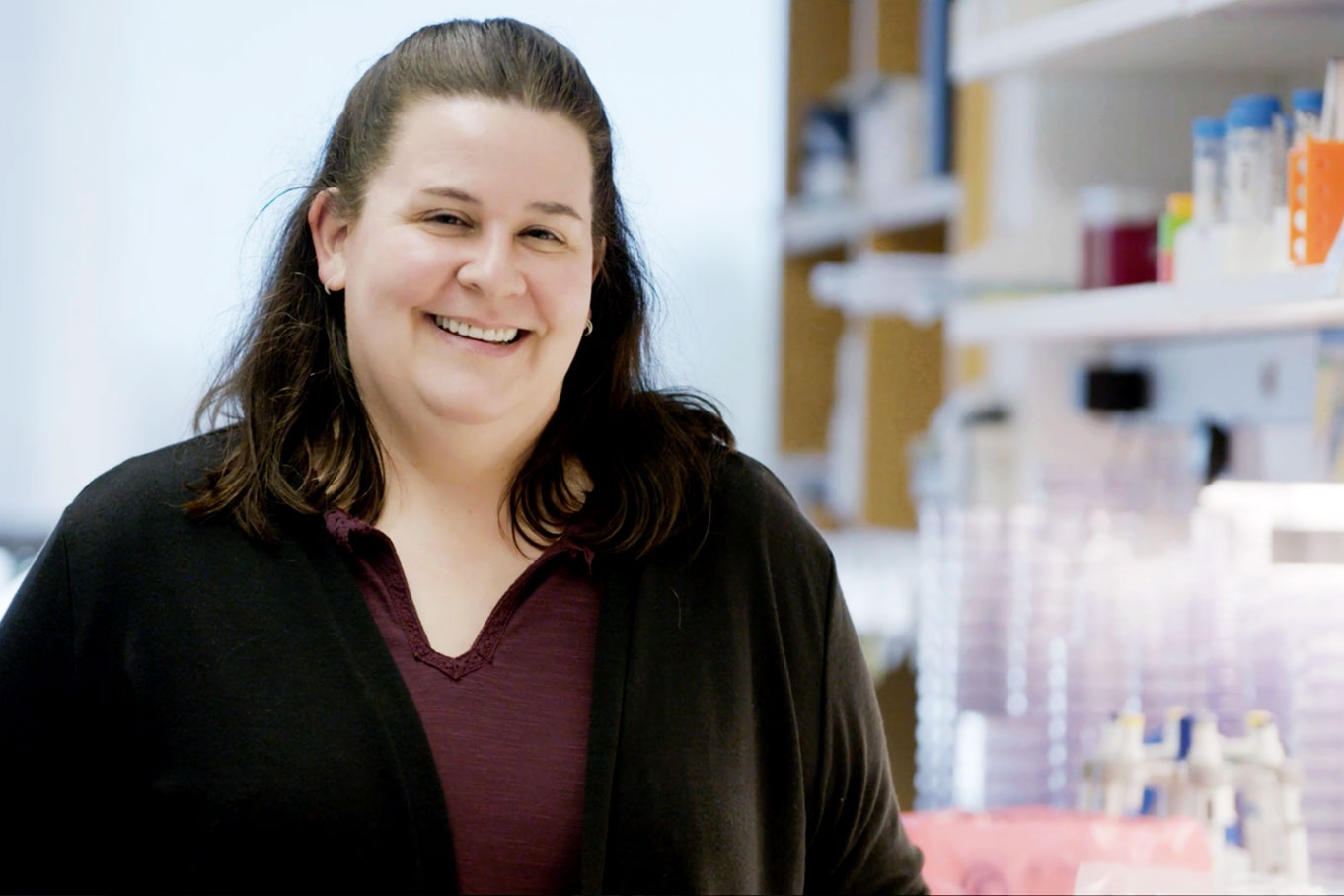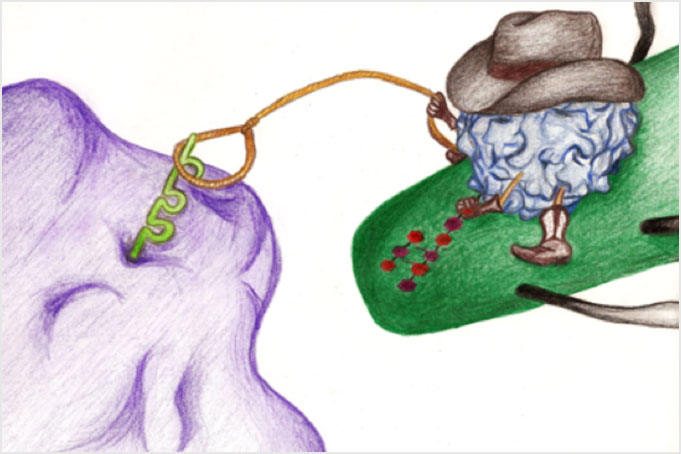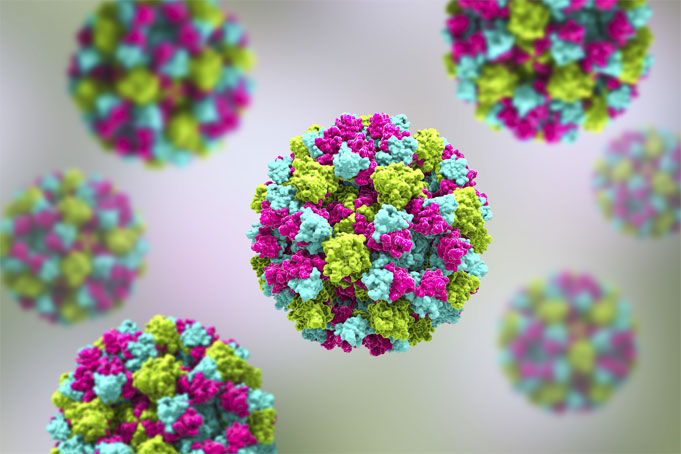Viral avenger

In a 2017 essay in PLOS Pathogens, UT Southwestern virologist Dr. Julie Pfeiffer wrote that she wouldn’t be surprised to find her name on a list of investigators pursuing “ridiculous, wasteful” projects. After all, she studies bacteria in poop to learn more about polio, the paralytic viral disease that was eradicated from the United States decades ago.
During 13 years of running her UTSW laboratory, Dr. Pfeiffer’s team has tackled many tough problems and worked on several viruses. Most of their advances stem from research on polio.
“Poliovirus grows like a weed. We can make stocks containing 10 billion viruses without even trying hard. We can introduce targeted mutations in the genome and generate mutant polioviruses within days,” says Dr. Pfeiffer, Professor of Microbiology and winner of the 2019 Edith and Peter O’Donnell Award in Science from The Academy of Medicine, Engineering, and Science of Texas. “Mouse strains exist that can be infected with polio, while lab members are immune due to vaccination. It’s a wonderful model system to study viral infection and eradication.”

Add to that the fact that although poliovirus has been studied for more than a century and much is known about this pathogen, investigations of the virus keep revealing new insights.
Tough to destroy
Eradicating the virus globally is proving tough. The World Health Organization says poliovirus still infects unvaccinated children in three countries: Afghanistan, Nigeria, and Pakistan. As straightforward as the virus is to work with in the lab, figuring out what it is up to during infection takes grit, which Dr. Pfeiffer has in abundance.
As a postdoctoral fellow at Stanford University, she showed that RNA viruses such as polio, Ebola, Zika, and influenza benefit from a sloppy replication strategy.
Her courage has been repeatedly tested since her arrival at UTSW in 2006, most dramatically when hers was the only lab in the world exploring a specific question that straddled virology and bacteriology and her graduate student encountered a confounding result.
“In such a situation, you can’t ask, ‘Well, what did other people who did this experiment find?’” Dr. Pfeiffer says. “No one else had done it.”

Dr. Pfeiffer and former graduate student Dr. Sharon Kuss-Duerkop gave mice antibiotics to knock down the friendly gut bacteria thought to protect them from harmful bacteria. The researchers hypothesized that intestinal bacteria would confer similar protection against viruses. Lacking gut bacteria, the test mice were expected to be overwhelmed by poliovirus. However, instead of succumbing to polio, the animals lacking intestinal bacteria had better survival rates than control mice.
“The exact opposite of what we were expecting!” says Dr. Pfeiffer of the finding that led to a more than two-year project in her laboratory.
The group tackled the issue head-on, trying different scientific approaches in a series of controlled experiments to confirm or refute the unexpected findings. “Dr. Kuss-Duerkop doggedly pursued the problem,” says Dr. Pfeiffer, who holds the Kern and Marnie Wildenthal President’s Research Council Professorship in Medical Science.
Imparting knowledge
Dr. Kuss-Duerkop, now a research instructor in Colorado, picks up the story: “One really striking result came from a follow-up test using a clever method that Julie had suggested.” The method involved inserting a light-sensitive dye into the poliovirus so that it would light up until the point of replication. Dr. Pfeiffer had learned the technique, used in polio research in the 1960s, during her own training.

Doing experiments in the dark by the glow of a photographer’s red light, the two scientists were able to show minuscule levels of replication occurring in the antibiotic-treated mice compared with controls that had intact gut microbiomes. The experiment helped confirm that gut bacteria were promoting viral replication – not protecting against it.
Through the many challenges encountered in the project, Dr. Pfeiffer remained calm.
“She is one of the most even-keeled persons that I know, always very reserved with her emotions,” Dr. Kuss-Duerkop remembers. “You would go into her office and be so excited about your results and slap them down on her desk and say, ‘Look, this is amazing!’”
Dr. Pfeiffer would look at the results, analyze them, and say, “OK, how did you do the experiment?”
Usually, Dr. Pfeiffer was already thinking of the next steps, the former graduate student says, adding that she found Dr. Pfeiffer’s positive, optimistic outlook in the face of inconclusive results very motivating.
From grief to joy
After one particularly bad day in the lab, Dr. Kuss-Duerkop went home with the goal of doing nothing more than relaxing. Once there, instead of relaxing, she began re-examining every piece of data she had collected and came upon an experiment using feces from germ-free mice that seemed like a missing piece of the puzzle. Resisting the strong desire to accept as gospel the highly desired results, she returned to the lab the next day and repeated the experiment, getting the same result. Like her mentor, she was calm, scientifically thorough, and only ready to believe when she was certain.
“When I showed these results to Dr. Pfeiffer, there was definitely emotion. She was excited. She was smiling. Then she said, ‘Oh, this is great, but what could be going on?’”
The work appeared destined for a high-impact journal, which meant they would need to determine a mechanism, which led them to isolate components of the bacterial cell wall and then determine the effects of each one on poliovirus. They found that lipopolysaccharide could enhance the virus’ infectivity.
Their determination paid off with a definitive report, published in Science, concluding that resident bacteria in the gut can promote viral illness.

One outgrowth of the work involves a pathogen called norovirus, which the Centers for Disease Control and Prevention labels the most common cause of vomiting and diarrhea. The virus spreads quickly among people in confined groups, such as on cruise ships or at evacuation centers following disasters. Despite 40 years of effort, human norovirus could not be cultured, severely limiting scientific progress. In fact, infecting human volunteers was the only way to study its replication.
That situation changed when a norovirus researcher familiar with the findings of the Pfeiffer lab added gut bacteria to cultures and the virus grew, finally creating a more humane way of studying the nasty bug’s replication.
All because of studies on the nearly eradicated but still valuable model system of polio, Dr. Pfeiffer says.
Perhaps Dr. Pfeiffer remained calm through the polio replication quandary because it wasn’t the transplanted Texan’s first rodeo. She faced a critical juncture in her career soon after arriving at UT Southwestern.
Digging in her heels
In 2006, Microbiology Chair and Professor Dr. Michael Norgard, holder of the B.B. Owen Distinguished Chair in Molecular Research, recruited her as the third virologist in the Department he was building. However, by her second year, she was the Department’s only virologist. Traditionally, virologists and bacteriologists have been in rather separate camps, so her initial feeling on hearing the news was of isolation.
Why did she stay?
“Well, I was the senior and only virologist in year two of a faculty position,” she says, displaying her optimism. “I knew Dr. Norgard wanted a balance between bacteriologists and virologists in the Department. It was so early in my career, and I wasn’t sure I was marketable. I had found a super-collaborative, supportive place here and I wanted to dig in my heels and help build things.”
Her practicality paid off. Dr. Norgard gave her the freedom to follow her investigations wherever they led – and he gave her a say in the Department’s future.
“We did make a big push to hire more virologists and Mike (Norgard) was great – he gave me a lot of freedom to pick whom we should add and all but one are still here,” she says. That group includes Drs. Nicholas Conrad, Ivan D’Orso, John Schoggins, and Don Gammon.
“They’re all great colleagues and scientists,” she says.
“Success in science is not about intellect so much as about your creativity, how well you can collaborate, and how easily you get out of your comfort zone.”
Actually, during her graduate training at the University of Michigan in her home state, she’d had a difficult time choosing between virology and bacteriology. As a second-year faculty member at UTSW, all her friends were bacteriologists, which gave her a chance to become reacquainted with the field.
“A big part of that was (Dr.) Lora Hooper, who still comes over once a week for dinner and drinks – frequently on my patio – where we talk about science and life,” she says. Dr. Hooper, Chair of Immunology and a Howard Hughes Medical Institute Investigator, runs UT Southwestern’s germ-free mouse colony, the source of the feces for that crucial poliovirus experiment.
Does Dr. Pfeiffer consider herself brave?
“Scientifically, yes,” she says, adding: “Success in science is not about intellect so much as about your creativity, how well you can collaborate, and how easily you get out of your comfort zone. It’s being scientifically scared to death but having a good support system, which is what I’ve found at UT Southwestern.”
Circling back, she says she understands why some nonscientists have trouble understanding the importance of model systems. There is, she explains, an important clinical reason for pursuing basic and translational questions.
“If you can understand the molecular basis of bacterial-viral interactions, then you can design novel, targeted antivirals that spare the good bacteria in the gut,” says Dr. Pfeiffer, one of a handful of polio specialists still working in Texas.
Does she mind being called one of the world’s foremost experts on poliovirus?
“That’s OK,” she says. “There are so few of us.”
Dr. Conrad, an Associate Professor of Microbiology, is a Southwestern Medical Foundation Scholar in Biomedical Research.
Dr. D’Orso is an Associate Professor of Microbiology.
Dr. Gammon, an Assistant Professor of Microbiology, is a W.W. Caruth, Jr. Scholar in Biomedical Research.
Dr. Hooper, holder of the Jonathan W. Uhr, M.D. Distinguished Chair in Immunology, is also a Nancy Cain and Jeffrey A. Marcus Scholar in Medical Research, in Honor of Dr. Bill S. Vowell.
Dr. Schoggins, an Assistant Professor, is a Nancy Cain and Jeffrey A. Marcus Scholar in Medical Research, in Honor of Dr. Bill S. Vowell.

